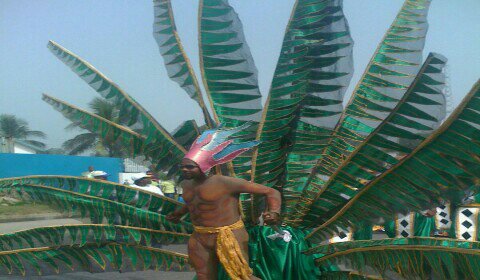Imagining the art of festive costuming
by Titi Brenda (Art Critic)
There are facts that attend some systemic efforts in costuming nature on carnival processions as may be observed through photography. I shall attempt within this brief space to highlight some of these speciality, with the carnival of 2015 Calabar exemplifying the events place.
Firstly the generally observable fact of an African carnival fest is the aesthetic appeal to nature that lies at the heart of its celebration of life. It is such that, almost to the point of worship, nature is everywhere present along the carnival tracks: nature revered, nature sacred, nature a blessing to humanity.
Similarly the ground is venerated: African tradition relates with the land, the Earth, as hallowed Mother that hosts all life, whether natural, as in birds of the air and land, or man-made, as in the arts, or even the photographic and other equipment used in the imitation of nature at carnival festivals.
So a carnival event is not only to propagate culture or promote tourism and enhance the economic potential of the state hosting the event. A carnival is even more of an opportunity for artistry and creative experimentation at many levels of individual and collective awareness of harmony with nature.
For the graphic artist, like myself, then, such occasion provides another mobile canvas to exercise imaginative skills, and for exercise of critical sensitivity. Overall, the carnival offers a wholesome kind of opportunity for creativity and scholarship regarding the symbolic presentation of life through costuming art, indicating plants, flowers, animals, birds and all the different flora and fauna which enamour a typical African landscape.
Somehow the artists involved may be likened to alchemists who manipulate the elements of air, water, earth and fire to enact multidimensional perspectives on reality. And the carnival, which provides the opportunity before, during and after the event, assumes a sort of combined art occasion along varied degrees of those grandly magical processions.
But there might be a catch in the visual results, leading to another critically observable fact from the photographs.
Using rigid, diagonal forms, most especially to depict the fauna (peacocks, for instance), may not come out quite successful from a point of visual realism.
Frequent lines and sharp ending curves have rendered the representation of solid forms mechanical and somewhat abstracted. Thence you can discern, when an attempt has been made to simulate with sharp, large lines, how the products end up looking stiffly, tacky or worse.
But here, in order to make for portraiture success, the seemingly less natural or more abstracted are rendered more colourfully by their designers in attempts toward enhancement and elegance of form.

- Peacock plumes
The great peacocks captured here in blue and green colours are common examples of this artistic methodology of imposing, larger than life creativity, emphasising the gaudy immensity and rugged rigidity of form.
Such costume materials have also included plastics and metals. The technological utility employed for compositions using plastic and metal artifices now seem rife with the import of the modernity of the African city hosting the occasion.
However, the imaginings of fauna with technical and human props tend to reduce their resemblance to nature no matter how these are achieved by use of sophisticated and expensive equipment. Needful to say, traditional masquerade performers have achieved similar breathtaking feats equipped with only local materials.

- Fire maidens
On the other hand, with much of the forms used for representing flora and the elements tending to be curvaceous, fluffy and flexible, there is no escaping the brilliant resonance of colours and hue which combine with materials of textile, feathers and reeds.
It is my considered opinion that much success abides in smooth ended curves and blended, vibrant colours. These imbue close cognisance to the flora and elements being represented, be they earth, fire or water.
Nevertheless, nature and carnival, captured through the lens of camera, altogether, comprise art in a lively play of colour and motion.
[…] NEXT: IMAGINING THE ART OF CARNIVAL COSTUMING […]